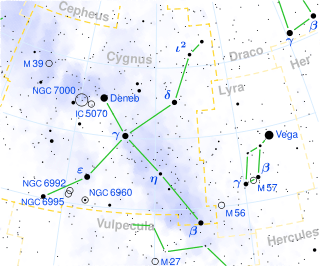CH Cygni
CH Cygni (CH Cyg / HIP 95413 / BD +49 2999) is a red giant, variable, symbiotic binary in the constellation Cygnus. It is the nearest symbiotic star to Earth, and one of the brightest, making it an ideal candidate for study.
 | |
| Observation data Epoch J2000 Equinox J2000 | |
|---|---|
| Constellation | Cygnus |
| Right ascension | 19h 24m 33.06773s[1] |
| Declination | +50° 14′ 29.1263″[1] |
| Apparent magnitude (V) | 5.60 – 8.49[2] |
| Characteristics | |
| Spectral type | M7IIIab + Be |
| Variable type | Z And and SR[2] |
| Astrometry | |
| Radial velocity (Rv) | -59.74[4] km/s |
| Proper motion (μ) | RA: -7.09[1] mas/yr Dec.: -59.74[1] mas/yr |
| Parallax (π) | 5.4642 ± 0.2172[5] mas |
| Distance | 600 ± 20 ly (183 ± 7 pc) |
| Orbit[6] | |
| Period (P) | 15.58±0.13 yr |
| Semi-major axis (a) | 8.5 AU |
| Eccentricity (e) | 0.122±0.024 |
| Inclination (i) | 84° |
| Semi-amplitude (K1) (primary) | 4.45±0.12 km/s |
| Details[6] | |
| Red giant | |
| Mass | 2 M☉ |
| Radius | 280 R☉ |
| Luminosity | 5012 L☉ |
| Temperature | 3,100 K |
| White dwarf | |
| Mass | 0.7 M☉ |
| Luminosity | 0.25 L☉ |
| Other designations | |
| Database references | |
| SIMBAD | data |
Properties
CH Cygni has a mass of 2 M☉ and a radius of 280 R☉. Its white-dwarf companion has a mass of 0.75 M☉, and the orbital period of the two stars is 5689 days.[6] CH Cygni is classified as M7IIIab + Be.
Observation history
The earliest observations of CH Cygni were made in 1890 by Pickering and Wendel using wedge photometer, and was classified as a M6III variable star in 1924.[7] In 1963 strong H I emissions were observed, indicating CH Cygni was likely in a symbiotic relationship with a white dwarf. Similar emissions were observed in 1965, 1967, 1977, 1992, and 1998.[8] The system was briefly thought to contain a third star[9] but this was later disproved.[6]
In 1984 bipolar jets were detected coming from CH Cygni, which were suspected to be due to accretion from its companion star.[8][7] The luminosity of the system decreased significantly in 1986, likely owing to dust thrown out of the system by the jets or a concurrent helium flash. This dust had dissipated by 2002, with subsequent luminosities returning to pre-1985 levels.
References
- van Leeuwen, F. (13 August 2007). "Validation of the new Hipparcos reduction". Astronomy & Astrophysics. 474 (2): 653–664. arXiv:0708.1752. Bibcode:2007A&A...474..653V. doi:10.1051/0004-6361:20078357.
- Samus, N. N.; Durlevich, O. V.; et al. (2009). "VizieR Online Data Catalog: General Catalogue of Variable Stars (Samus+ 2007-2013)". VizieR On-line Data Catalog: B/gcvs. Originally Published in: 2009yCat....102025S. 1. Bibcode:2009yCat....102025S.
- Famaey, B.; Pourbaix, D.; Frankowski, A.; Van Eck, S.; Mayor, M.; Udry, S.; Jorissen, A. (18 February 2009). "Spectroscopic binaries among Hipparcos M giants". Astronomy & Astrophysics. 498 (2): 627–640. arXiv:0901.0934. Bibcode:2009A&A...498..627F. doi:10.1051/0004-6361/200810698.
- Brown, A. G. A.; et al. (Gaia collaboration) (August 2018). "Gaia Data Release 2: Summary of the contents and survey properties". Astronomy & Astrophysics. 616. A1. arXiv:1804.09365. Bibcode:2018A&A...616A...1G. doi:10.1051/0004-6361/201833051.
- Hinkle, Kenneth H; Fekel, Francis C; Joyce, Richard R (2009). "Infrared Spectroscopy of Symbiotic Stars. Vii. Binary Orbit and Long Secondary Period Variability of Ch Cygni". The Astrophysical Journal. 692 (2): 1360. arXiv:0811.0631. Bibcode:2009ApJ...692.1360H. doi:10.1088/0004-637X/692/2/1360.
- Mikołajewski, M.; Mikołajewska, J.; Khudiakova, T.N. (August 1990). "A long-period symbiotic binary CH Cygni. I - A hundred years' history of variability". Astronomy and Astrophysics. 235 (1–2): 219–233. Bibcode:1990A&A...235..219M. ISSN 0004-6361.
- Burmeister, M.; Leedjärv, L. (9 July 2009). "Spectroscopy of the symbiotic binary CH Cygni from 1996 to 2007". Astronomy & Astrophysics. 504 (1): 171–180. arXiv:0907.2017. Bibcode:2009A&A...504..171B. doi:10.1051/0004-6361/200911686.
- Hinkle, Kenneth H.; Fekel, Francis C.; Johnson, Diana S.; Scharlach, Werner W. G. (March 1993). "The triple symbiotic system CH Cygni". The Astronomical Journal. 105: 1074. Bibcode:1993AJ....105.1074H. doi:10.1086/116494.